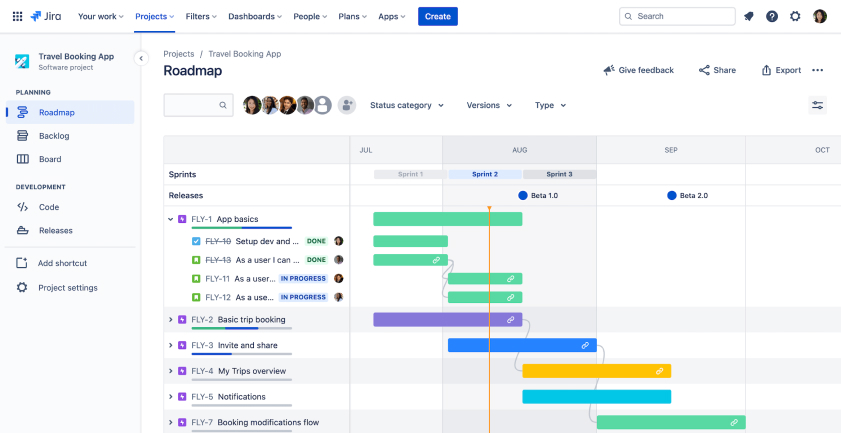
When it comes to managing projects, whether big or small, finding the right project management tool is crucial for ensuring efficiency, collaboration, and productivity. Asana and Jira are two popular choices in the world of project management, each offering a unique set of features and capabilities. In this comprehensive comparison, we will dive deep into the world of Asana vs. Jira to help you make an informed decision about which tool suits your needs best.
Introduction to Asana and Jira
Asana
Asana is a web-based project management and collaboration tool that was founded in 2008 by Dustin Moskovitz and Justin Rosenstein, both former Facebook employees. The platform is designed to help teams organize and manage their work by providing a central hub for tasks, projects, and communication. Asana’s user-friendly interface and intuitive features have made it a popular choice for a wide range of organizations, from small startups to large enterprises.
Jira
Jira, on the other hand, is a product of Atlassian, a software company that specializes in collaboration and productivity tools. Originally launched in 2002 as a bug tracking tool, Jira has evolved into a comprehensive project management and issue tracking platform. It is particularly favored by software development teams and IT professionals for its robust features and flexibility.

Now, let’s delve deeper into the specific features, pros, and cons of Asana and Jira to help you decide which tool aligns better with your project management needs.
Features and Capabilities
Asana
- Task Management
Asana excels in task management. It allows users to create tasks, assign them to team members, set due dates, and add descriptions and attachments. Tasks can be organized into projects and sorted into customizable lists, making it easy to keep track of priorities.
- Collaboration
Collaboration is at the heart of Asana. It offers features like comments, task followers, and the ability to mention team members to keep everyone in the loop. Additionally, you can attach files directly to tasks for seamless communication.
- Project Tracking
Asana provides a visual project timeline view that helps teams see how tasks and projects fit together over time. This feature is useful for planning and scheduling projects effectively.
- Customization
Asana is highly customizable, allowing users to create custom fields, templates, and workflows tailored to their specific needs. This flexibility is particularly valuable for teams with unique project requirements.
- Integrations
The tool offers a wide range of integrations with popular apps like Slack, Google Workspace, and Microsoft Office, enabling users to streamline their workflow by connecting Asana with other essential tools.
Jira
- Issue Tracking
Jira’s core strength lies in issue tracking. It provides a robust system for creating, assigning, and tracking issues, making it ideal for software development projects. Users can customize issue types and workflows to match their processes.
- Agile Project Management
Jira offers comprehensive support for agile project management methodologies like Scrum and Kanban. Agile boards, sprint planning, and backlog management are some of the features that make it a favorite among development teams.
- Advanced Reporting
Jira provides powerful reporting and analytics capabilities, allowing users to gain insights into project progress, team performance, and issue resolution times. Customizable dashboards and charts make it easy to visualize data.
- Integration with Development Tools
Jira seamlessly integrates with development tools like Bitbucket and GitHub, enabling a seamless connection between code repositories and project management. This integration is a significant advantage for software development teams.
- Automation
Automation rules in Jira help reduce manual tasks and improve workflow efficiency. You can automate repetitive processes, notifications, and actions, saving time and ensuring consistency.

Pros and Cons
Asana
Pros:
- User-Friendly Interface: Asana’s interface is highly intuitive, making it easy for both new and experienced users to navigate and get started quickly. Its clean design encourages adoption across the organization.
- Flexible Task Management: Asana excels in task management, allowing users to create tasks, assign them to team members, set due dates, and add descriptions and attachments. The flexibility of task customization ensures it can adapt to various project needs.
- Great for Collaboration: Collaboration is one of Asana’s strong suits. Features like comments, task followers, and the ability to mention team members facilitate seamless communication within the platform. Real-time updates keep everyone in the loop.
- Project Tracking: Asana’s visual project timeline view provides a clear overview of how tasks and projects fit together over time. This feature is invaluable for planning, scheduling, and tracking project progress effectively.
- Customization: Asana offers a high degree of customization. Users can create custom fields, templates, and workflows tailored to their specific project requirements. This adaptability is particularly valuable for teams with unique processes.
- Broad Integrations: Asana boasts an extensive list of integrations with popular apps such as Slack, Google Workspace, Microsoft Office, and more. This seamless connectivity streamlines workflow and enhances productivity by connecting Asana with other essential tools.
Cons:
- Complex Pricing Structure: Asana’s pricing can be perceived as complex, especially for larger teams with diverse needs. The variety of plans and add-ons may require careful consideration to choose the most cost-effective solution.
- Limited Agile Support: While Asana offers some agile features, it may not provide the same comprehensive support for agile methodologies as Jira. Teams heavily reliant on Scrum or Kanban may find certain aspects lacking.
- Learning Curve for Advanced Features: Despite its user-friendliness, some users may experience a learning curve when delving into Asana’s more advanced features. While basic task management is straightforward, leveraging all of Asana’s capabilities may require additional training.
Jira
Pros:
- Robust Issue Tracking: Jira’s core strength lies in issue tracking. It offers a comprehensive system for creating, assigning, and tracking issues, making it an ideal choice for software development and issue resolution.
- Agile Project Management: Jira is a powerhouse for agile project management. It provides full support for agile methodologies such as Scrum and Kanban, complete with agile boards, sprint planning, and backlog management.
- Advanced Reporting and Analytics: Jira’s reporting and analytics capabilities are second to none. Users can gain valuable insights into project progress, team performance, and issue resolution times. Customizable dashboards and charts help visualize data effectively.
- Integration with Development Tools: Jira seamlessly integrates with development tools like Bitbucket and GitHub, creating a strong connection between code repositories and project management. This integration is invaluable for software development teams.
- Automation: Jira offers automation rules that can significantly reduce manual tasks and enhance workflow efficiency. Users can automate repetitive processes, notifications, and actions, saving time and ensuring consistency in processes.
Cons:
- Steep Learning Curve: Jira’s extensive feature set can be overwhelming for new users, resulting in a steep learning curve. Teams may need dedicated training to make the most of the platform, especially when dealing with advanced features.
- Pricing Considerations: While Jira offers a free version, the cost of premium plans can be prohibitive for small businesses and startups with limited budgets. The pricing structure may require careful budget planning.
- Interface Complexity: Some users find Jira’s interface less intuitive compared to Asana’s, which can lead to frustration and resistance to adoption, especially among non-technical team members.
- Overkill for Small Projects: For very small projects or non-technical teams, Jira’s extensive features may be excessive and could potentially introduce unnecessary complexity.
Pricing
Asana
Asana offers a tiered pricing structure that caters to a variety of needs. Their plans include:
- Basic: Free plan with essential task and project management features for small teams.
- Premium: Starts at $13.49 per user per month (when billed annually) and includes additional features like custom fields and timeline view.
- Business: Starts at $30.49 per user per month (when billed annually) and adds advanced reporting and automation capabilities.
- Enterprise: Custom pricing with premium support and additional security features, suitable for large organizations.

Jira
Jira also offers a tiered pricing model, with different options to choose from:
- Free: Ideal for small teams or personal use, offering basic issue tracking and agile boards.
- Standard: Starts at $7 per user per month and includes advanced features like automation and enhanced permissions.
- Premium: Begins at $14 per user per month, offering additional scalability, advanced roadmaps, and priority support.
- Enterprise: Custom pricing, suitable for large organizations, with advanced security and customization options.
When comparing pricing, it’s essential to consider your team’s size, specific needs, and budget constraints.
Integrations
Both Asana and Jira understand the importance of integrating with other tools to streamline workflow and improve productivity. Here’s a brief overview of their integration capabilities:
Asana
Asana offers a wide range of integrations through its app marketplace, including but not limited to:
- Communication Tools: Slack, Microsoft Teams, Gmail
- Cloud Storage: Google Drive, Dropbox, Box
- Development Tools: GitHub, Bitbucket, Jira (yes, you can integrate Jira with Asana)
- Time Tracking: Toggl, Harvest
- CRM: Salesforce
- Marketing: HubSpot, Marketo
These integrations allow you to connect Asana with the tools your team already uses, reducing the need to switch between applications constantly.
Jira
Jira also provides an extensive list of integrations, including:
- Development Tools: Bitbucket, GitHub, Jenkins
- Testing and QA: Zephyr, TestRail
- Continuous Integration: Bamboo, CircleCI
- Confluence: Seamless integration with Atlassian’s collaboration tool
- Service Desk: Jira Service Management for IT teams
Jira’s focus on development means it has a rich ecosystem of integrations tailored to software development processes.
Use Cases
To make an informed choice between Asana and Jira, consider your specific use case and industry. Here’s a breakdown of scenarios where each tool excels:
Asana
- Marketing and Creative Teams: Asana’s user-friendly interface and task management features make it an excellent choice for marketing teams handling campaigns, content creation, and design projects.
- Project Managers: Asana’s customizable features and project tracking capabilities are beneficial for professionals overseeing a variety of projects.
- Non-Technical Teams: Asana’s versatility makes it suitable for teams beyond software development, such as HR, sales, and customer support.
Jira
- Software Development: Jira is the go-to tool for software development teams, offering powerful issue tracking, agile support, and seamless integration with development tools.
- Agile Teams: Scrum, Kanban, and agile teams benefit from Jira’s specialized agile features, including boards, sprints, and backlogs.
- IT and DevOps: IT and DevOps teams can leverage Jira’s automation and integration capabilities to streamline processes and improve collaboration.

Customer Support and Community
Both Asana and Jira offer customer support and have active user communities. However, the level of support and the nature of the communities differ.
Asana
Asana provides customer support through email and a help center with articles, guides, and tutorials. They also have an active user community where users can share best practices and seek help from other Asana enthusiasts.
Jira
Jira offers various support options, including email, phone, and an extensive knowledge base. Being an Atlassian product, it benefits from a vast user community and a marketplace for add-ons and plugins. Many third-party vendors also offer consulting and support services for Jira.
Security and Compliance
Security and compliance are critical considerations, especially for larger organizations and industries with stringent regulations.
Asana
Asana offers robust security features, including data encryption, two-factor authentication (2FA), and access controls. They also comply with GDPR and HIPAA, making it suitable for organizations with specific data security requirements.
Jira
Jira, being part of the Atlassian suite, offers strong security measures, including data encryption, access controls, and audit logs. Atlassian has also achieved various compliance certifications, such as SOC 2, ISO 27001, and FedRAMP, making it a suitable choice for organizations with strict security and compliance needs.
Mobile Accessibility
In today’s mobile-centric world, the ability to access project management tools on the go is crucial. Both Asana and Jira offer mobile apps for iOS and Android devices.
Asana
Asana’s mobile app is well-received for its user-friendly design and ease of use. It allows users to manage tasks, projects, and conversations while on the move.
Jira
Jira’s mobile app provides access to core features, including issue tracking and agile boards. However, some users find its interface less intuitive compared to Asana’s mobile app.

Conclusion: Tailoring Your Choice
In the ultimate showdown of Asana vs. Jira, your decision hinges on a multitude of factors. The two platforms have distinctive strengths that can greatly enhance your project management experience, but the choice should be as unique as your organization’s needs. Let’s delve deeper into the nuances to help you make an even more informed choice.
Understanding Your Team Dynamics
Asana is your go-to pick if your team values an easy onboarding process and a platform that feels intuitive from day one. Its user-friendly interface shines in creative and marketing teams where collaboration and project tracking go hand in hand. Additionally, if your organization spans across various departments beyond software development, Asana’s versatility can be a boon. It ensures everyone can comfortably use the tool without an extensive learning curve.
Jira, on the other hand, becomes an indispensable ally when your focus is on software development or IT. Its robust issue tracking capabilities, coupled with extensive support for agile methodologies like Scrum and Kanban, make it a no-brainer choice for development teams. If you’re working on intricate coding projects and require advanced reporting, Jira delivers insights that can drive efficiency and quality.
Sizing Up Your Budget
Both Asana and Jira offer a range of pricing options to cater to different budgets and team sizes. For small teams or personal use, the free plans are viable options. However, when your team starts to expand, budget considerations come into play.
Asana’s pricing model is slightly complex, with the cost scaling as you move from the free Basic plan to Premium, Business, and Enterprise tiers. While the free plan serves small teams well, larger organizations may find the pricing structure intricate, especially when catering to diverse needs across departments.
Jira’s pricing structure follows a similar trajectory, with free, Standard, Premium, and Enterprise plans. Small teams can leverage the free version, but as your team grows, you’ll need to budget for the added features in the paid tiers. It’s worth noting that Jira’s premium plans can be on the higher end, which might be a consideration for budget-conscious organizations.
Charting Your Project Ecosystem
Integrations play a pivotal role in streamlining your project management workflow. Both Asana and Jira recognize this and offer extensive integration options, but their focus and strengths differ.
Asana boasts a wide array of integrations, catering to communication tools, cloud storage, development tools, time tracking, CRM, and marketing applications. If your team relies on an eclectic mix of tools for different tasks, Asana’s integrations can help create a seamless experience.
Jira, with its roots in software development, excels in integrating with development tools like Bitbucket, GitHub, and Jenkins. If your project ecosystem revolves around coding, Jira’s integration prowess ensures a frictionless connection between code repositories and project management.
Tailoring to Your Use Case
Ultimately, the choice between Asana and Jira hinges on your unique use case. Here are some scenarios to consider:
- Marketing and Creative Teams: If you’re leading marketing campaigns, content creation, or design projects, Asana’s user-friendly interface and task management capabilities might fit like a glove.
- Project Managers: Asana’s customizable features and project tracking prowess are valuable assets for project managers who oversee diverse projects.
- Non-Technical Teams: Asana’s adaptability makes it suitable for a wide range of teams, from HR and sales to customer support.
- Software Development: For development teams, especially those adhering to agile methodologies, Jira’s issue tracking, and agile support are unrivaled.
- Agile Teams: Scrum, Kanban, and other agile teams can harness Jira’s specialized agile features for seamless sprint planning and backlog management.
- IT and DevOps: IT and DevOps teams can tap into Jira’s automation and integration capabilities to optimize processes and foster collaboration.
The Support and Security Angle
Your choice should also consider the level of support and security that aligns with your organization’s needs.
Asana offers customer support through email and a knowledge base with articles, guides, and tutorials. Its user community can be a valuable resource for insights and best practices.
Jira, being an Atlassian product, offers various support channels, including email, phone, and a rich knowledge base. With its extensive user community and a thriving marketplace for add-ons, Jira users have access to an ecosystem of support options.
In terms of security and compliance, both tools offer robust measures, with data encryption, access controls, and compliance certifications. Your choice should be guided by your specific security and compliance requirements.
Navigating on Mobile
In a mobile-centric world, the ability to access project management tools on the go is crucial. Both Asana and Jira offer mobile apps for iOS and Android devices.
Asana’s mobile app stands out for its user-friendly design and ease of use. It ensures that you can efficiently manage tasks, projects, and conversations even while on the move.
Jira’s mobile app, while functional, may require a bit of a learning curve for users unfamiliar with the platform. Some users find Asana’s mobile app more intuitive.
In the epic showdown of Asana vs. Jira, there’s no room for a one-size-fits-all answer. Your choice should be as unique as your organization’s DNA, reflecting your team dynamics, budget considerations, project ecosystem, use case, and support and security requirements.
Both Asana and Jira offer free trials, providing an excellent opportunity to experiment with each platform. By doing so, you can gain hands-on experience and determine which tool best aligns with your team’s workflow and objectives. Ultimately, the right choice will empower your team to collaborate efficiently and deliver successful projects, whether you’re crafting code or crafting marketing campaigns.

For 8 years, Madeline has been working as an CGI specialist and digital video producer since his student years. Now, she’s our main consultant on every technical aspect that may arise during our tests and research.
In case you haven’t found something, or have a question on some specific guide, product, or just a feature, we are always ready to help.
